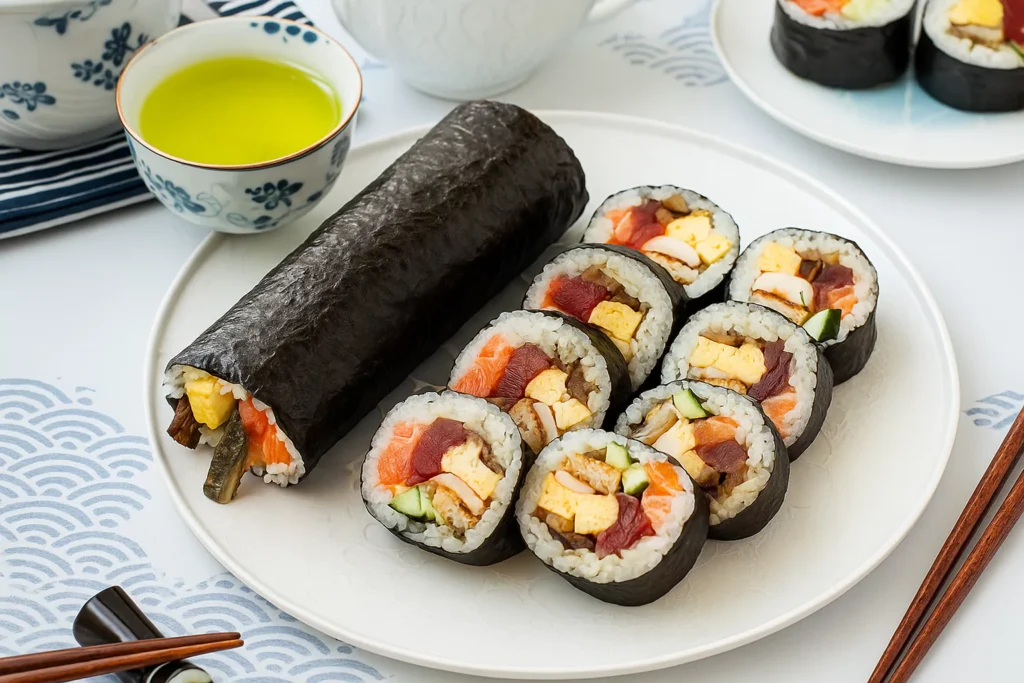Have you ever wondered why some people eat a thick sushi roll in total silence while facing a specific direction? This curious tradition, rooted in Japanese culture, involves more than just good taste. It’s believed to bring luck, health, and happiness. Welcome to the world of Ehomaki, a unique sushi roll enjoyed during Setsubun, the Japanese festival that marks the beginning of spring.
In this detailed guide, you will learn how to make Ehomaki from scratch, understand its cultural significance, and discover helpful tips to make your homemade version a success. Whether you’re an experienced cook or trying sushi-making for the first time, this recipe is accessible, meaningful, and fun to prepare.
Jump to Recipe Print RecipeWhat Makes Ehomaki Special?
Ehomaki is more than just a sushi roll. It’s a cultural ritual. Traditionally eaten on Setsubun (the day before the first day of spring in Japan), Ehomaki symbolizes a fresh start and the wish for a healthy and fortunate year ahead.
- Preparation Time: Approximately 2 hours, including rice preparation and ingredient assembly.
- Difficulty Level: Moderate. While some experience with sushi rolling helps, beginners can follow along with clear instructions.
- Highlight: Ehomaki is eaten in silence while facing the year’s lucky direction to welcome good luck and prosperity.
If you enjoy unique sushi creations, you might also love our Delicious Chicken Tempura Sushi recipe. It’s a crispy, flavorful twist on traditional rolls and a great option for those who prefer cooked ingredients.
Table of Contents
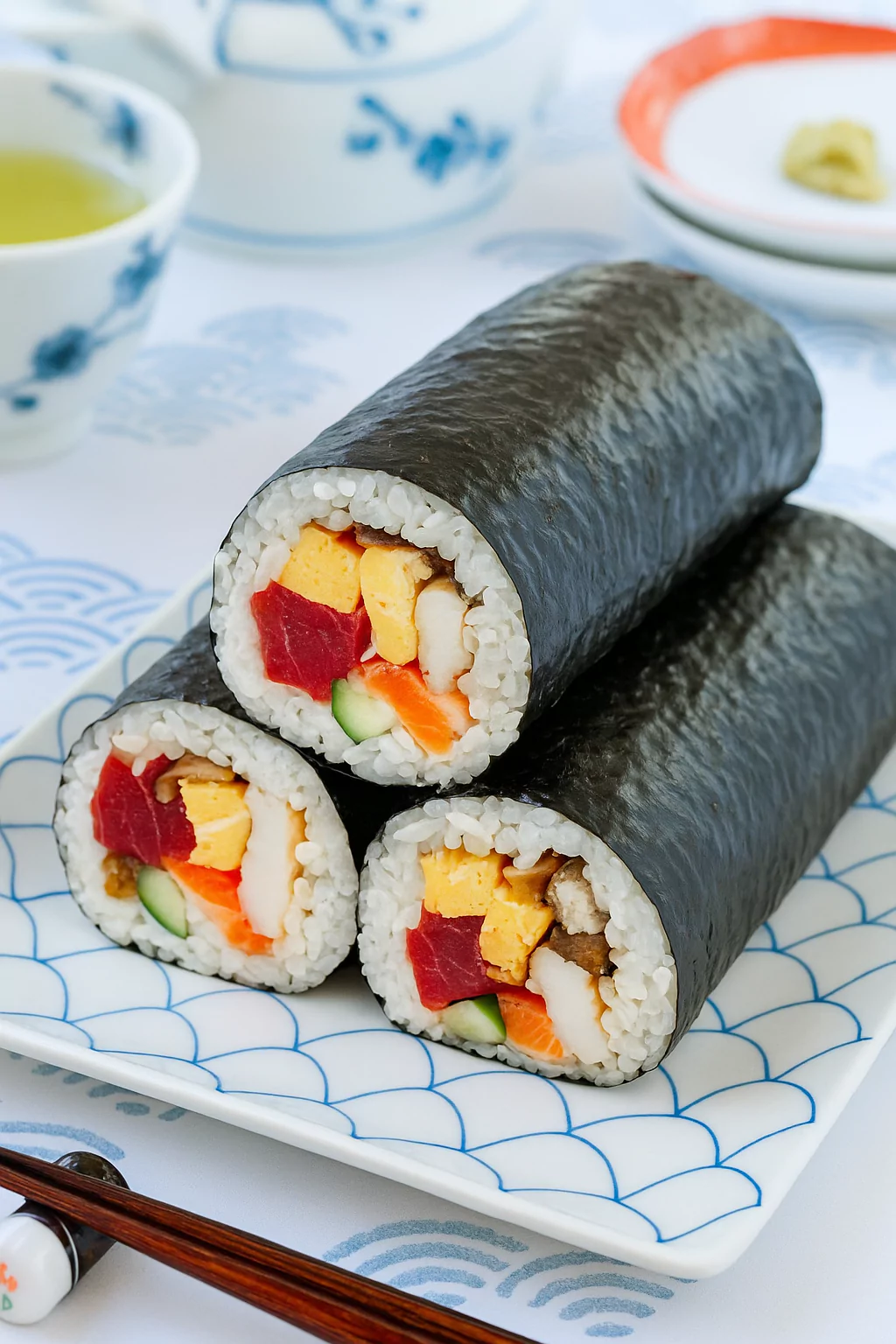
Ehomaki 恵方巻 @JapanDishes
What is Ehomaki?
The word “Ehomaki” combines “eho” (meaning lucky direction) and “maki” (meaning roll). This custom is believed to have started in Osaka during the late Edo period (1603–1868) and early Meiji period (1868–1912). Back then, it was a local tradition, but it gained national popularity in the 1990s thanks to promotions by sushi shops and supermarkets.
On Setsubun, people face the year’s designated lucky direction—called “eho”—and eat an uncut sushi roll without speaking, turning their gaze, or pausing. For 2025, the auspicious direction is west-southwest. Cutting the roll is avoided because it is believed to “cut off” good fortune. Eating it whole is a way to preserve and absorb all the luck the roll contains.
Essential Ingredients for Ehomaki
This recipe includes a combination of flavors, textures, and colors. Each ingredient represents balance and harmony.
Main Fillings:
- 1 Japanese or Persian cucumber
- 1 Tamagoyaki (Japanese rolled omelet)
- 4 cooked large shrimp, deveined and boiled
- 1 grilled unagi (freshwater eel) fillet
- Simmered Shiitake Mushrooms (prepared 1-2 days in advance)
- 6 oz sashimi-grade salmon, sliced into strips
- 6 oz sashimi-grade tuna, sliced into strips
For Rolling:
- 4 cups cooked sushi rice, seasoned with vinegar
- 4 sheets of nori (seaweed)
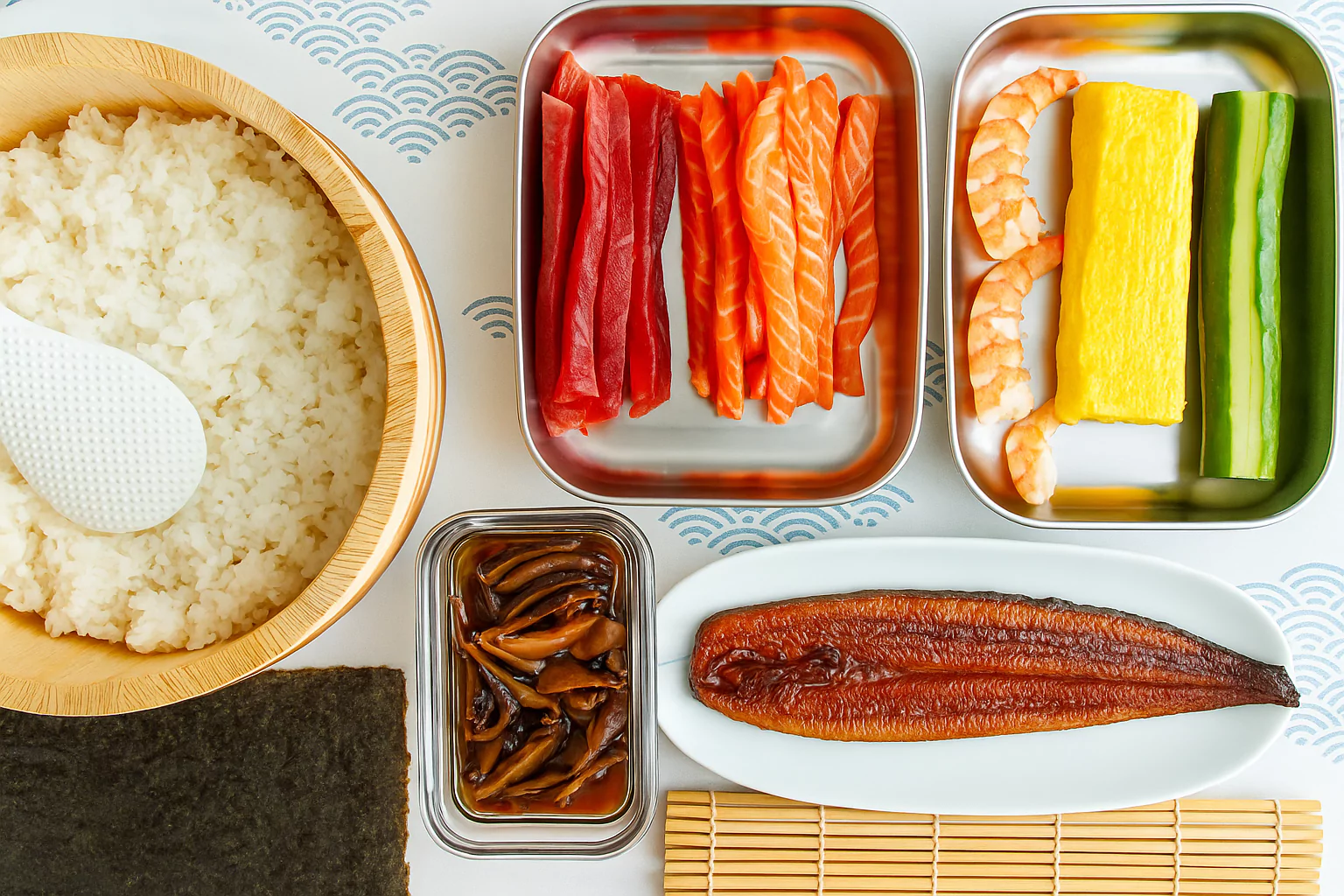
Ehomaki Ingredients @JapanDishes
Substitutions and Variations:
- Instead of unagi, you can use grilled chicken or tofu.
- If sashimi-grade fish is unavailable, substitute with cooked alternatives like smoked salmon.
- Vegetarian versions can include pickled daikon, avocado, or cooked spinach.
Step-by-Step Instructions: How to Prepare Ehomaki
1. Prepare in Advance
Making Ehomaki involves a few ingredients that can be prepared ahead of time:
- Simmered Shiitake Mushrooms: Cook these in a mixture of soy sauce, mirin, sugar, and dashi for deep flavor. Store in the fridge up to two days.
- Tamagoyaki: This sweet, layered omelet is made from eggs, sugar, and soy sauce. It can also be prepared a day or two in advance.
- Cooked Shrimp: Devein large shrimp with the shells on, boil them in water with a splash of sake, and peel them after cooking.
2. Sushi Rice Preparation
The rice forms the foundation of the roll:
- Rinse 1½ cups of Japanese short-grain rice until the water runs clear.
- Cook the rice using a rice cooker or pot.
- While still hot, mix with sushi vinegar (rice vinegar, sugar, and salt).
- Allow it to cool to room temperature before using.
For perfect rice texture, make sure your grains don’t get too sticky. If you’re struggling with sticky rice, check out this helpful guide: Sushi Rice: 3 Steps to Fix Sticky Grains for simple solutions.
3. Prepare the Fillings
Start by trimming the ends of the cucumber. Then slice it lengthwise into thin sticks. You should end up with about eight evenly sized cucumber strips for crisp texture in your roll.
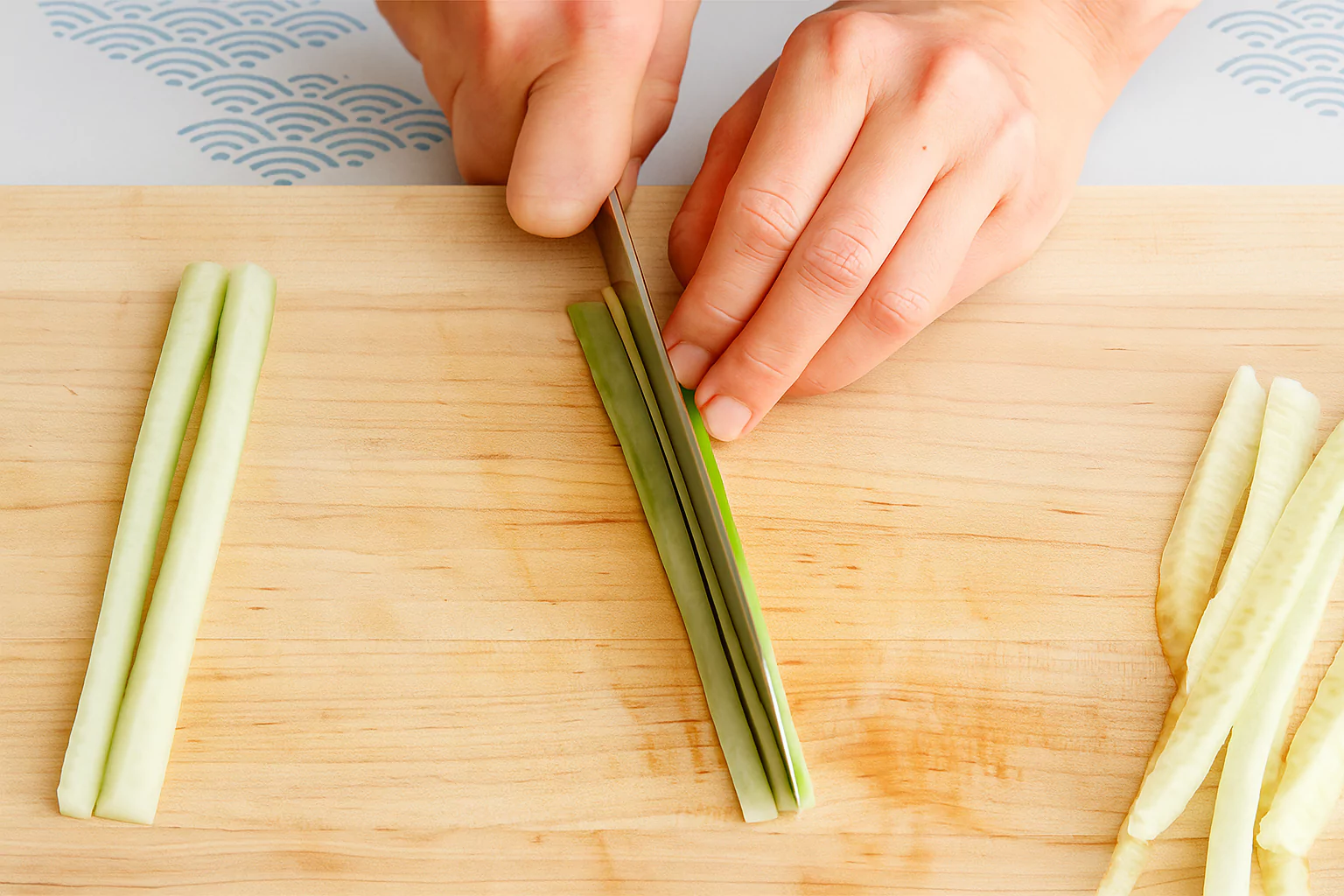
Next, take your tamagoyaki and carefully cut it lengthwise into eight strips. The slightly sweet flavor of the egg will balance the savory ingredients in your Ehomaki.
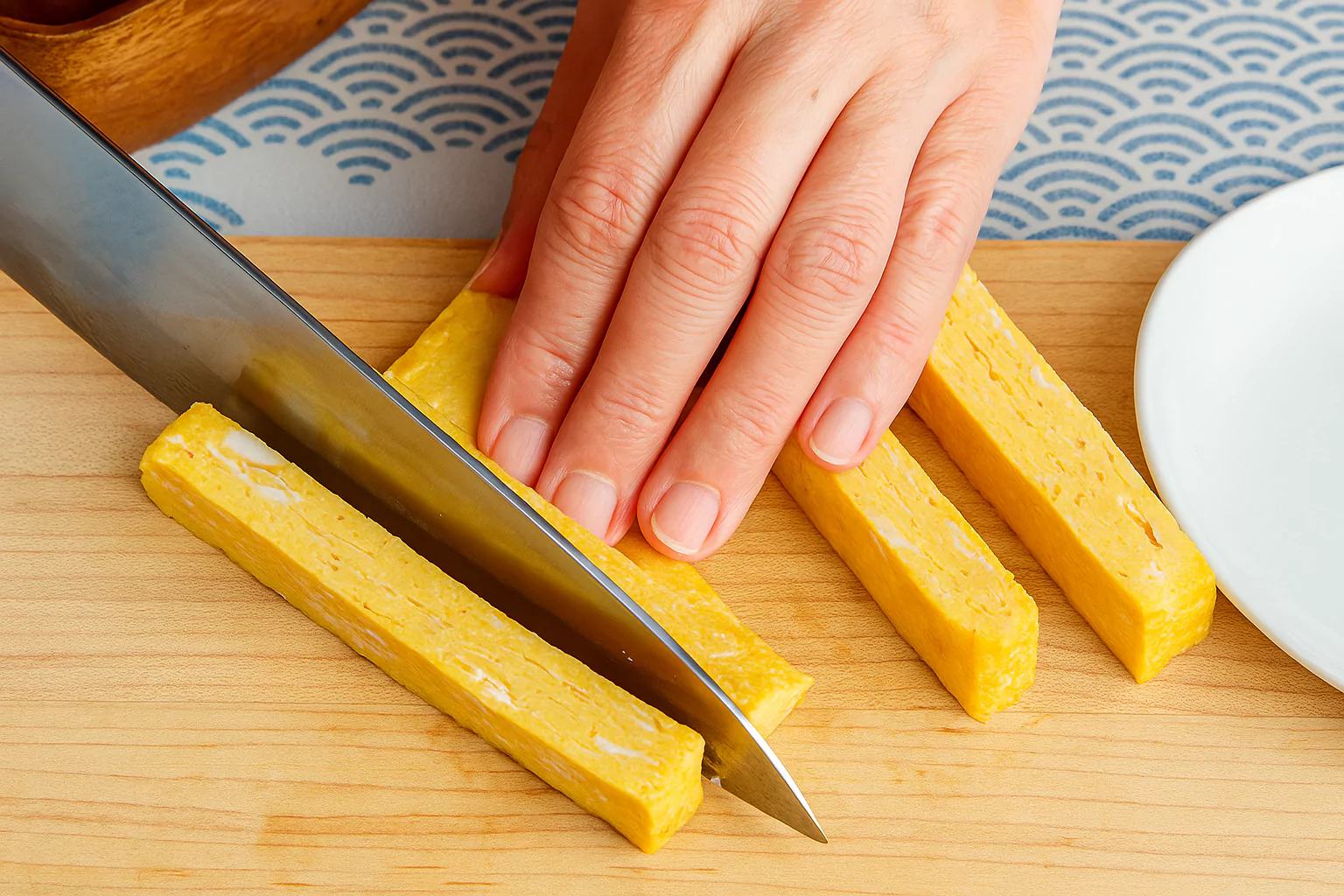
Prepare the shrimp by slicing each one in half lengthwise. This makes them thinner and easier to layer when rolling the sushi.
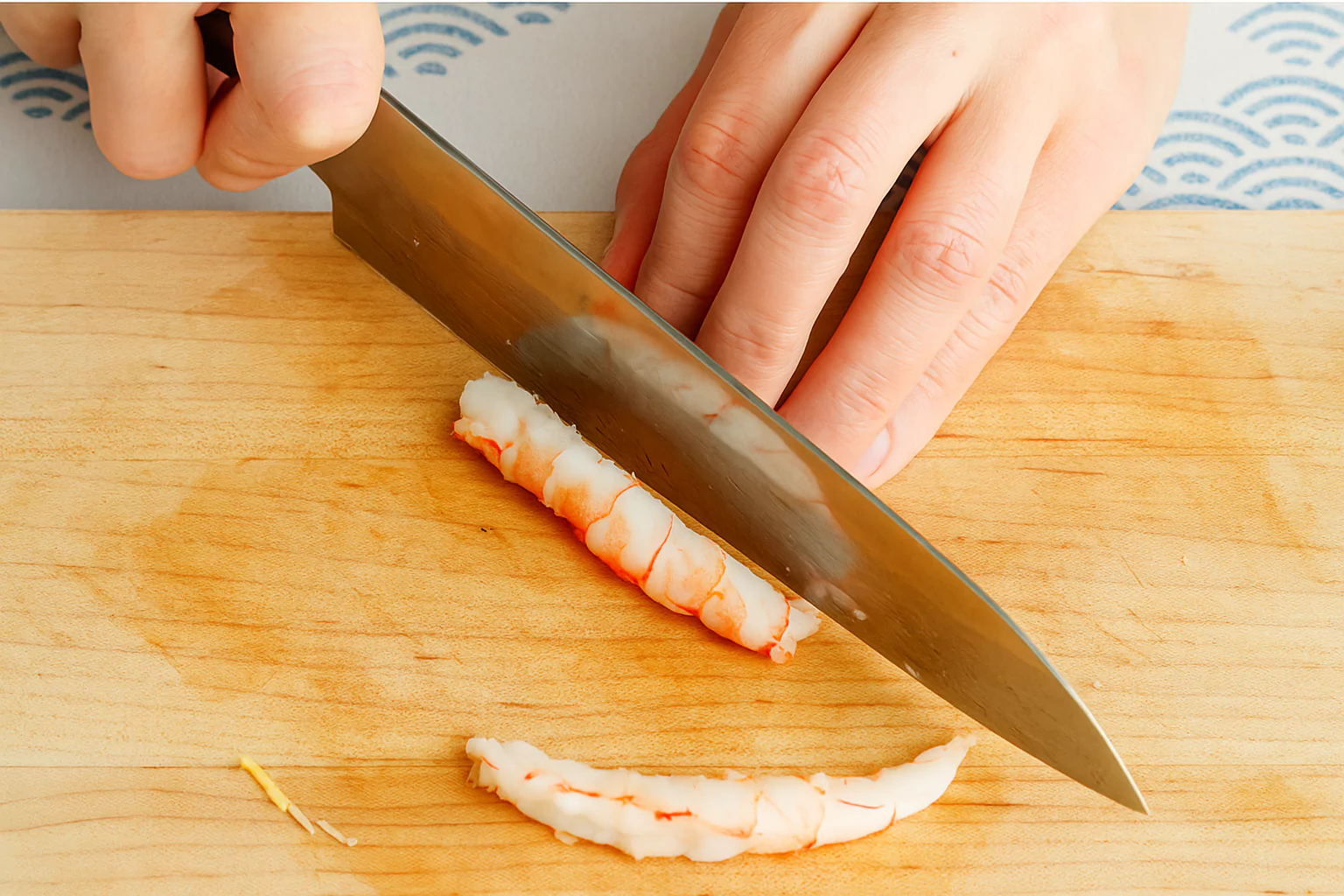
Now, slice the grilled eel (unagi) fillet into four long strips. Its rich and smoky flavor will add depth to the overall taste of the roll.
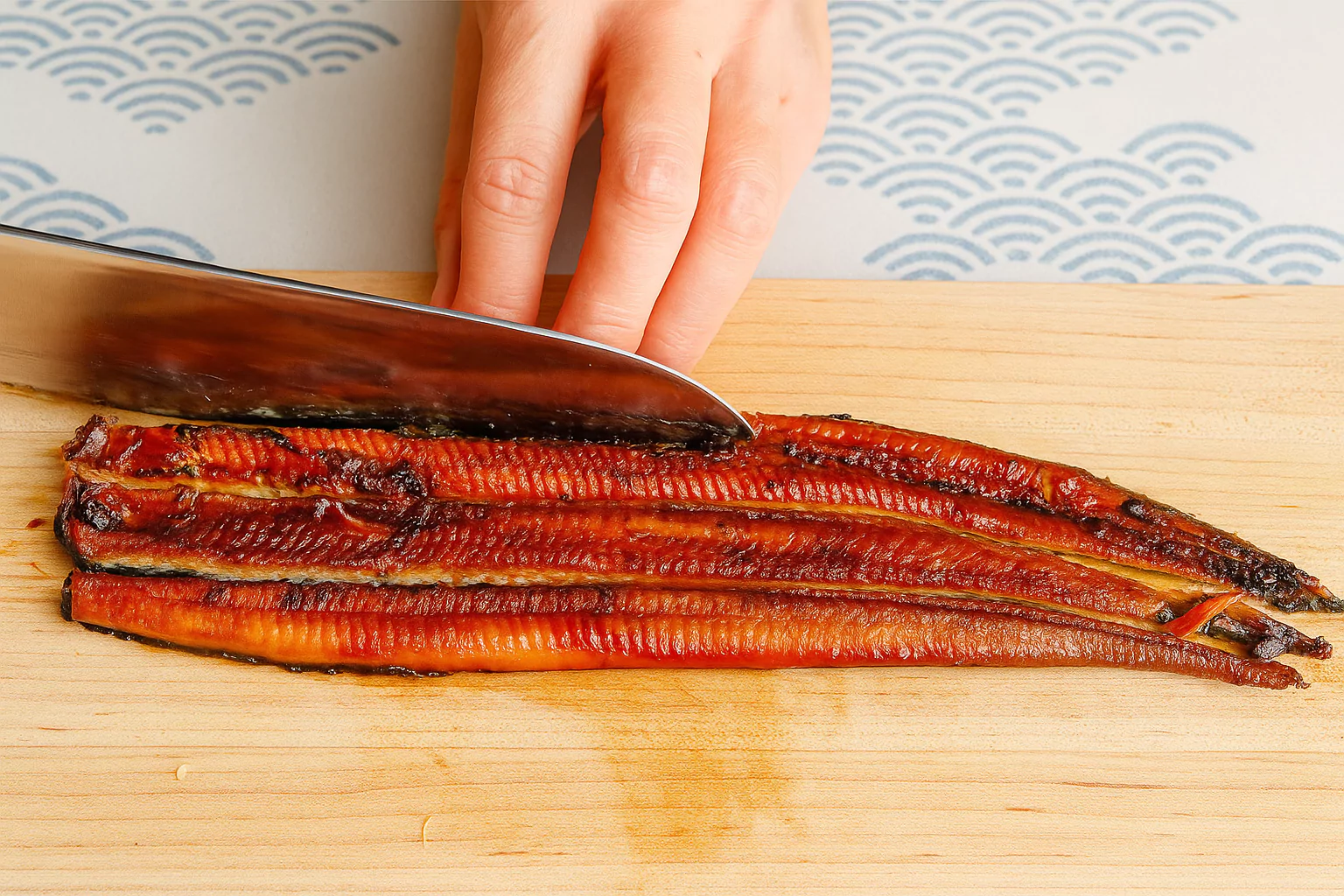
Lastly, take your sashimi-grade salmon and tuna blocks and cut them lengthwise into thin, even strips. These should be similar in thickness to the other ingredients to ensure the roll stays even.
Assembling the Ehomaki Roll
Rolling sushi may seem intimidating, but with practice, it becomes second nature. Here are some expert tips from Hana to help you get it right.
Hana’s Recipe Tips:
- Advance Preparation: Having the mushrooms and omelet ready beforehand speeds up the process.
- Even Rice Spread: Wet your fingers with tezu (vinegar water) to prevent rice from sticking. Spread rice evenly for better roll structure.
- Leave Empty Strips: Leave a 1-inch gap at the top and a 1/2-inch gap at the bottom of the nori to help seal the roll neatly.
- Layer with Care: Place easy-to-roll ingredients like cucumber and tamagoyaki at the bottom. Place the delicate items like shiitake near the top.
- Use a Bamboo Mat: Roll the sushi tightly using a bamboo mat to maintain its shape and firmness.
How to Roll:
- Lay a sheet of nori shiny side down on the bamboo mat.
- Spread 1 cup of sushi rice evenly over the nori, leaving the top and bottom strips empty.
- Begin layering your fillings horizontally across the rice starting from the bottom:
- 2 cucumber sticks
- 1 strip of eel
- 2 shrimp halves
- 2 strips of tamagoyaki
- A spoonful of simmered shiitake
- 2 strips each of salmon and tuna
- Lift the bottom edge of the bamboo mat and roll over the fillings tightly, pressing gently.
- Continue rolling and use the mat to form and tighten the shape.
- Press gently with the mat to seal the roll.

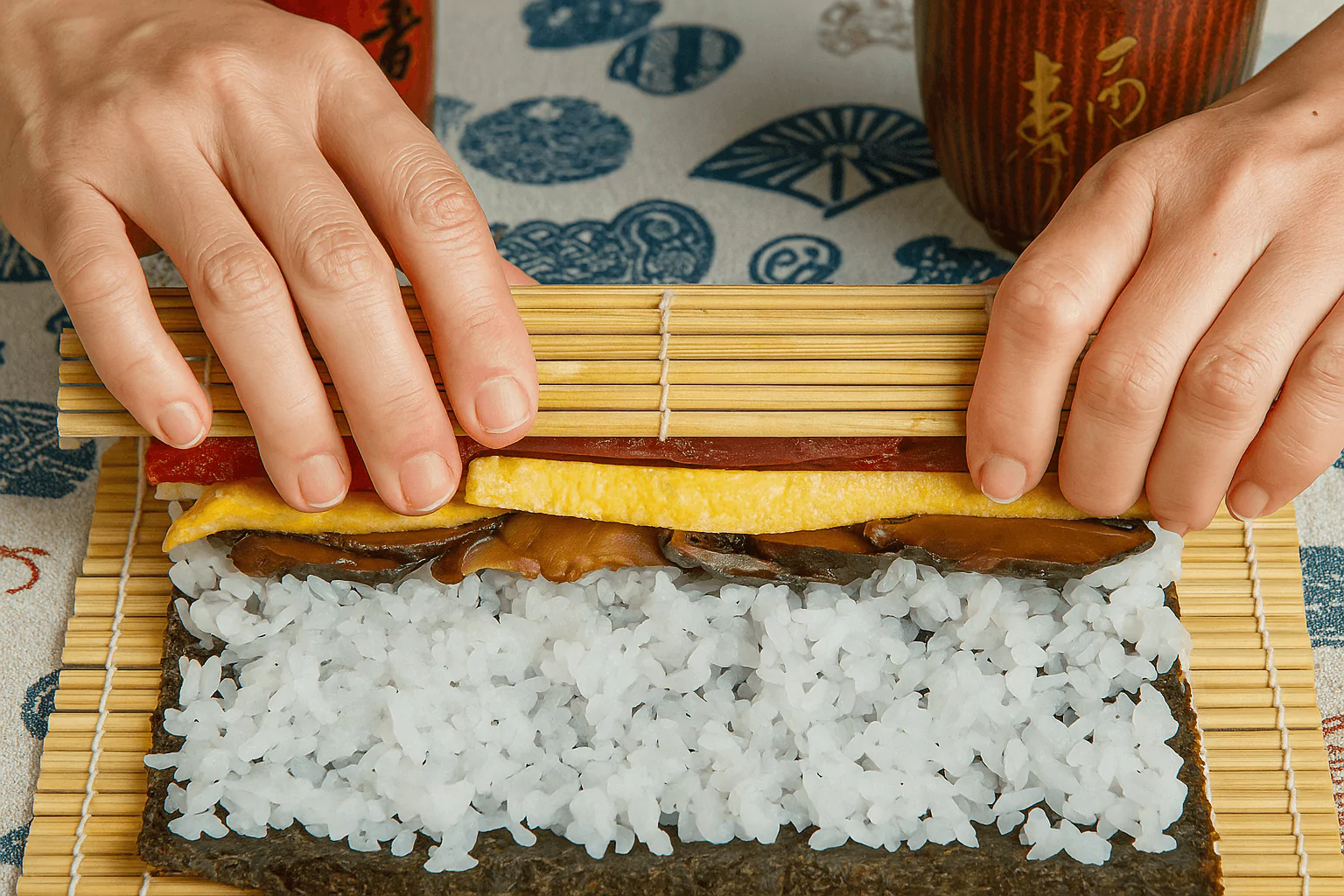

Repeat the steps to make the remaining three rolls.
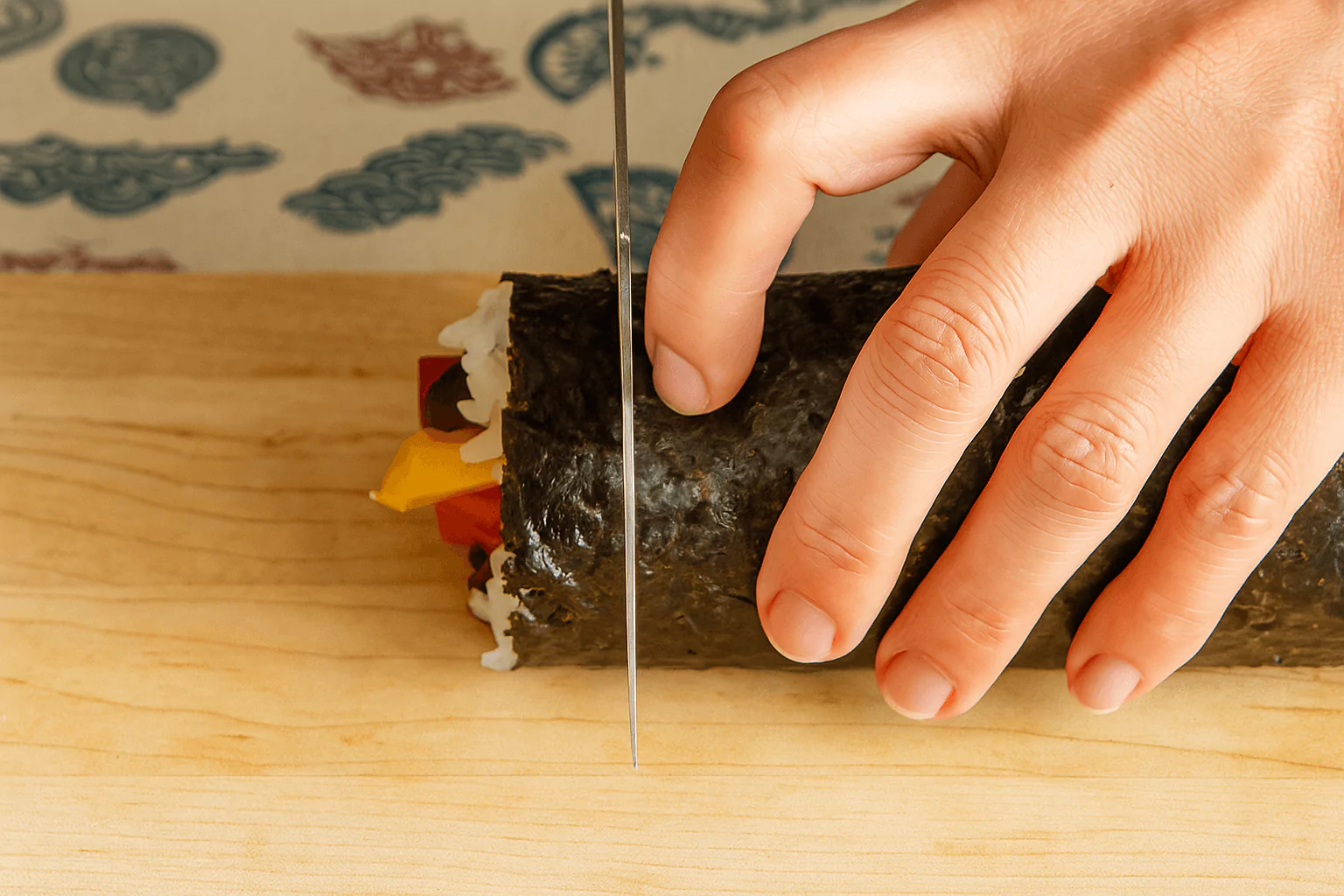
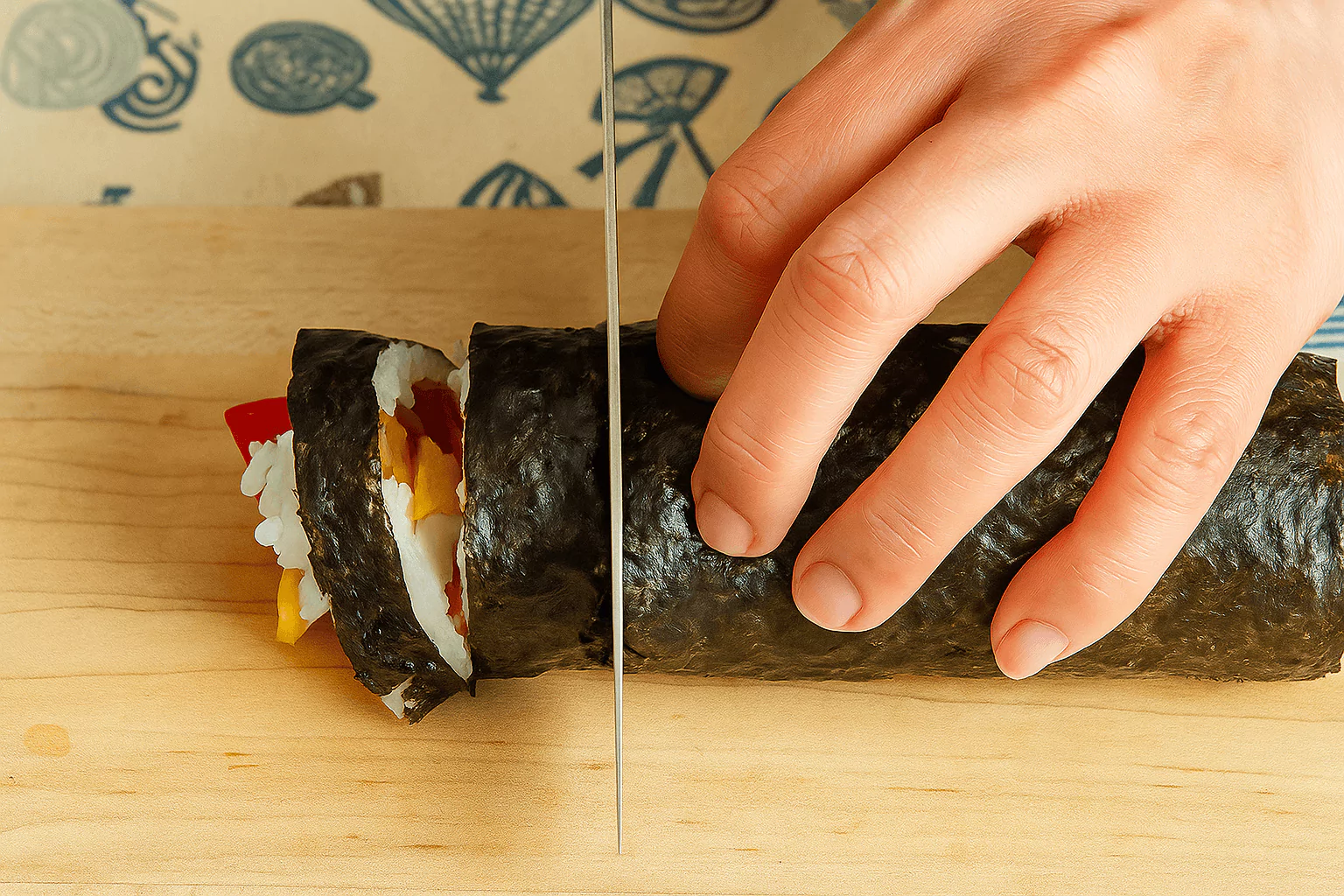
Storage and Make-Ahead Tips
Ehomaki is best enjoyed fresh. The rice texture and nori quality decline if stored too long.
- If necessary, wrap the uncut rolls tightly in plastic wrap.
- Place a thick towel over the plastic to maintain moisture.
- Avoid refrigeration as it hardens the rice.
- Do not freeze.
For advance prep:
- Store prepared fillings like mushrooms and tamagoyaki in airtight containers.
- Cook the rice just before assembling.
Ehomaki (Setsubun Sushi Roll) 恵方巻
Course: AppetizersCuisine: JapaneseDifficulty: Medium4
servings30
minutes1
hour420
kcalEhomaki is a thick, uncut sushi roll traditionally eaten on Setsubun, the day before spring in Japan. This step-by-step guide walks you through how to make Ehomaki with colorful fillings, seasoned sushi rice, and cultural meaning.
Ingredients
- Main Fillings:
1 Japanese or Persian cucumber, cut into 8 long sticks
1 Tamagoyaki (Japanese rolled omelet), sliced into 8 strips
4 large shrimp, deveined, boiled, and sliced lengthwise
1 grilled unagi (freshwater eel) fillet, sliced into 4 long pieces
Simmered shiitake mushrooms (prepared 1–2 days ahead)
6 oz sashimi-grade salmon, cut into strips
6 oz sashimi-grade tuna, cut into strips
- For Rolling:
4 cups cooked sushi rice (seasoned with sushi vinegar)
4 sheets nori (dried seaweed)
Small bowl of tezu (vinegared water) for handling rice
Directions
- Prepare in Advance:
Cook the shiitake mushrooms in a soy sauce-based broth and refrigerate. Make tamagoyaki and cool. Devein the shrimp, boil with a splash of sake, and peel after cooking. - Cook the Sushi Rice:
Rinse and cook 1½ cups of Japanese short-grain rice. Mix with sushi vinegar while warm and let it cool to room temperature. - Cut the Fillings:
Slice the cucumber and tamagoyaki into long strips. Cut each shrimp in half lengthwise. Slice the eel into four strips and prepare the sashimi fish into long, even slices. - Assemble the Roll:
Lay a sheet of nori shiny side down on a bamboo mat. Spread 1 cup of sushi rice over it, leaving a 1-inch gap at the top and a ½-inch gap at the bottom. - Layer the Ingredients:
Place cucumber, eel, shrimp, and tamagoyaki near the bottom. Add mushrooms toward the top. Finally, place salmon and tuna on top. - Roll the Sushi:
Use the bamboo mat to roll tightly from the bottom. Apply gentle pressure as you roll to form a firm shape. Seal with the rice edge. - Repeat:
Repeat the same process for the remaining three sheets of nori. - Serve:
Traditionally, serve the roll whole (uncut) while facing the lucky direction of the year. For 2025, it is west-southwest.
Notes
- Avoid slicing the roll on Setsubun to preserve luck and tradition.
If you prefer cooked options, swap raw fish for smoked salmon or grilled tofu.
For perfect rice, avoid overly sticky grains. You can refer to this guide to fixing sticky sushi rice.
Store fillings separately in the fridge a day in advance to save time on rolling day.
Creative Recipe Variations
While tradition calls for seven fillings, the contents can be adjusted based on taste or dietary needs.
Ideas for Alternative Fillings:
- Grilled tofu or eggplant for a plant-based option
- Avocado and cream cheese for a modern twist
- Pickled vegetables for added crunch
- Tempura vegetables or shrimp for a different texture
- Shiso leaves or radish sprouts for freshness
Conclusion: Embrace Tradition with Flavor and Meaning
Ehomaki is more than a meal; it’s a symbolic and seasonal celebration. Making it at home allows you to participate in a meaningful Japanese tradition, even if you’re far from Japan. The process of choosing ingredients, preparing them thoughtfully, and rolling the sushi with intention adds layers of significance to the dish.
By following the steps in this guide, you can enjoy Ehomaki in your own kitchen. It’s a great way to explore Japanese culture, practice mindfulness, and share a beautiful custom with loved ones.
Frequently Asked Questions (FAQs)
1. Do I have to use raw fish in Ehomaki? No. While sashimi-grade fish is traditional, you can use cooked proteins such as shrimp, grilled chicken, tofu, or even imitation crab.
2. Why is the roll eaten uncut? Cutting the roll is thought to cut off luck. Eating it whole while facing the lucky direction is a key part of the tradition.
3. Can I make Ehomaki vegetarian or vegan? Yes. Substitute fish and meat with ingredients like pickled radish, cucumber, avocado, cooked spinach, or tofu.
4. What if I can’t find some ingredients? The ingredients can be flexible. The most important thing is to keep the roll colorful and varied in texture.
5. Can I refrigerate Ehomaki? It’s best to eat Ehomaki the same day it’s made. If storing, wrap it well in plastic and cover it with a towel to keep the rice soft.
6. What direction should I face when eating it? The direction changes every year. For 2025, face west-southwest while eating.
By understanding the origins and steps behind this cherished dish, you’re not just making sushi. You’re honoring a ritual that has brought comfort and good fortune to many generations. Enjoy your homemade Ehomaki, and may it bring you a prosperous and joyful year ahead.
Want to explore more about Japanese culture? Check out this detailed guide on Kokeshi dolls and 10 unique designs collectors love to discover another fascinating tradition from Japan.
